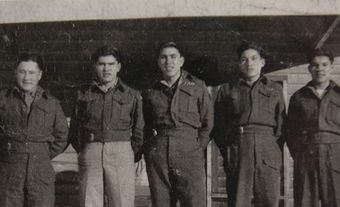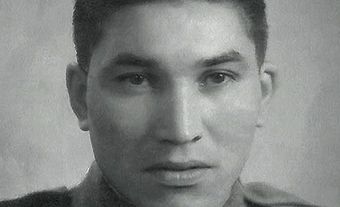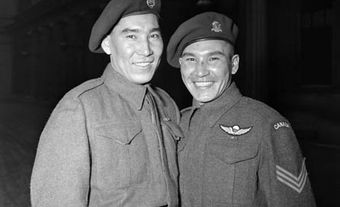Louis Levi Oakes (also known as Tahagietagwa), Mohawk soldier, war hero, steelworker, public works supervisor (born 23 January 1925 in St. Regis, QC; died 28 May 2019 in Snye, QC). During the Second World War, Oakes was a code talker for the United States Army. Code talkers used their Indigenous languages to encode radio messages to prevent the enemy from understanding them. When he passed away at age 94, Oakes was the last Mohawk code talker. (See also Cree Code Talkers and Indigenous Peoples and the World Wars.)
Early Life
Louis Levi Oakes grew up on Akwesasne (Mohawk) territory, which straddles the Quebec, Ontario and New York borders. (See also Indigenous Territory.)
When he was 18, he joined the United States Army. After training at Fort Drum in upstate New York, he moved to a base in Louisiana. Once authorities realized Oakes was fluent in Kanien’kéha, the Mohawk language, he trained as a code talker and was a Technician Fourth Grade in Company B, 442nd Signal Battalion.
Code Talkers
Code talkers translated important messages into their Indigenous language, sent them by military radio or telephone to another code talker who spoke the same language and then translated them back into English. As some military terms had no Indigenous equivalent, Indigenous words were used to represent them, such as turtle for tank, iron fish for submarine and hummingbird for fighter plane.
Code talkers have had a legacy helping Allied forces during the world wars. (See also Indigenous Peoples and the World Wars.) The first use of code talkers in the US military occurred during the First World War. In October 1918, American field communications were being intercepted by the Germans during a major offensive. The enemy tapped into telephone lines, deciphered codes and captured dispatch runners. When a captain overheard two Indigenous soldiers from the Choctaw Nation talking, he immediately realized the possibilities this offered for sending messages. Other Choctaw speakers were found and test messages sent over a field telephone. The messages received at the other end of the line were translated back into English quickly and correctly. The Choctaw Telephone Squad was the result; the very first use of code talking.
During the Second World War, the US military established formal policies to recruit and train Indigenous language speakers as code talkers. The army was first in 1940, followed later by the marines in 1941–42 and then the navy. Native speakers from the Navajo, Kiowa, Hopi, Creek, Seminole, Mohawk and several other Indigenous nations were recruited. In all, 33 Indigenous languages were used.
Canada also employed code talkers during the Second World War, often using Cree speakers to disguise their communications. (See also Cree Language.) Like the American code talkers, all of them were sworn to secrecy. The Canadian system was declassified in 1963 and the American one in 1968. The codes used by the code talkers were never broken. (See also Cree Code Talkers.)
During the Second World War, Louis Levi Oakes and 16 others from Akwesasne worked as code talkers in the war against Japan. Oakes served in the South Pacific, New Guinea and the Philippines, as well as a four-month stint in Japan after the war ended.
Post War
Louis Levi Oakes was honourably discharged from the army on 15 February 1946 after six years of service. He spent 30 years in the Buffalo, New York, area as a steelworker, an occupation that employed many Mohawk people. He married in 1950 and had 10 children. Oakes later worked for the council of Akwesasne’s department of public works for another 30 years, eventually retiring as supervisor.
Recognition
In 2008, US president George W. Bush signed the Code Talkers Recognition Act, which authorized Congressional Medals to recognize and honour the contributions of code talkers. Unique gold medals were struck for each “Native American tribe” that had a member who was a code talker, while silver duplicate medals were prepared for individual code talkers. Louis Levi Oakes was presented his medal on 28 May 2016 in Akwesasne by a US congresswoman. His medal bears the inscription “Akwesasne Mohawk Code Talkers.”
In 2016, Oakes was awarded the Silver Star for gallantry in action against the enemy, the US armed forces’ third-highest award. On 15 May 2018, Oakes was inducted into the New York State Senate Veterans’ Hall of Fame. Shortly afterward, he was presented with the New York State Liberty Medal, the highest civilian honour the state awards.
On 4 December 2018, Oakes’s contributions to the war effort were recognized in Ottawa. The National Chief of the Assembly of First Nations (AFN), Perry Bellegarde, presented Oakes with a star blanket and a beaded medallion at an AFN special chiefs assembly in Ottawa. The same day, after an introduction by the Speaker, the House of Commons gave Oakes a standing ovation. Afterward, he met privately with Prime Minister Justin Trudeau.

The 10th Mountain Division (LI) and the 10th Combat Aviation Brigade of the American military helped provide a fitting military funeral for the esteemed Louis Levi Oakes, the last Mohawk code talker.
Legacy and Significance
Louis Levi Oakes was one of at least 3,090 First Nations peoples in Canada who served in the armed forces during the Second World War. Ironically, although the federal government had actively discouraged the use of Indigenous languages, notably through the residential school system, during the Second World War they proved to be an important and winning asset for the Allies.

 Share on Facebook
Share on Facebook Share on X
Share on X Share by Email
Share by Email Share on Google Classroom
Share on Google Classroom







